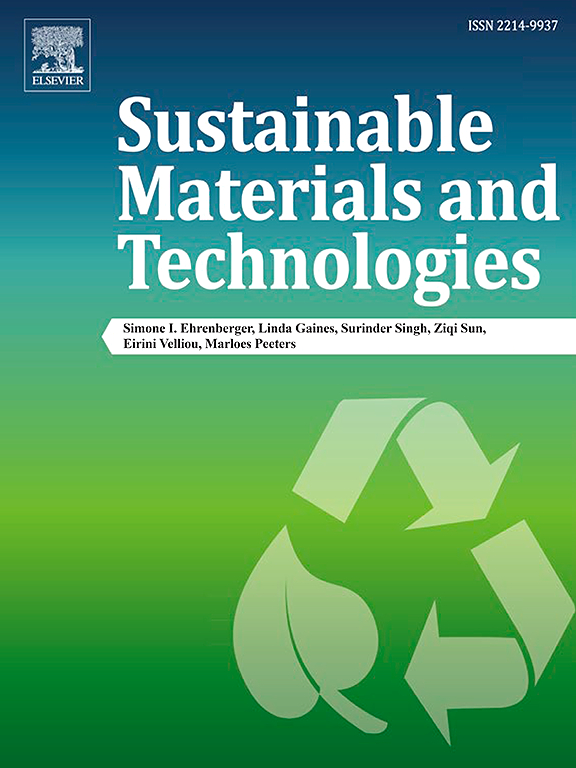ag修饰、Fe和cu掺杂ZnO/g-C3N4纳米复合光催化剂对污染物降解和析氢活性的增强
IF 8.6
2区 工程技术
Q1 ENERGY & FUELS
引用次数: 0
摘要
本文采用化学沉淀法制备了负载ag和掺杂Cu、fe的ZnO/g-C3N4纳米复合材料。在可见光照射下,通过降解亚甲基蓝(MB)和水裂解制氢来评价纳米复合材料的光催化性能。多项研究结果证实了Cu、Fe和Ag在光催化剂结构中的结合,这也为提高光催化性能提供了必要的特征。透射电镜(TEM)分析证实了Ag和ZnO在g-C3N4中的成功整合。光学和电化学特性结果表明,在Ag负载和Cu和Fe掺杂的作用下,ZnO和g-C3N4之间形成异质结构,增强了电荷分离,提高了光电流密度,并将Ag负载样品的带隙减小到2.73 eV。负载ag的ZnO/g-C3N4纳米复合材料的光催化活性最好,在180 min后完全降解MB。Mott-Schottky分析结合清除实验表明,超氧自由基是驱动光催化活性的关键。因此,这些结果证实了Ag的加入改变了ZnO/g-C3N4纳米复合材料中的电荷转移路径,从传统的II型机制转变为z型结构。ag掺杂纳米复合材料的析氢量为1566 μmol/g.h,高于Cu和Fe掺杂纳米复合材料。Ag在改善纳米复合材料在环境修复和可再生能源发电中的光催化功能方面似乎比Fe和Cu更显著。本文章由计算机程序翻译,如有差异,请以英文原文为准。
Ag-modified, Fe, and cu-doped ZnO/g-C3N4 nanocomposite photocatalyst with enhanced activity toward degradation of pollutant and hydrogen evolution
In this paper, Ag-loaded and Cu and Fe-doped ZnO/g-C3N4 nanocomposites were produced by a chemical precipitation method. The photocatalytic performance of these nanocomposites was assessed by degrading methylene blue (MB) and producing hydrogen via water splitting under visible light illumination. The incorporation of Cu, Fe, and Ag into the photocatalyst's structure was confirmed by multiple findings, which also provided insights into its features that are essential for enhancing photocatalytic performance. The successful integration of Ag and ZnO into the g-C3N4 was confirmed by transmission electron microscope (TEM) analysis. Optical and electrochemical characteristics results have illustrated that creating a heterostructure between ZnO and g-C3N4 with effects of Ag loading and Cu and Fe doping enhanced charge separation, higher photocurrent density, and reduced band gap to 2.73 eV for the Ag-loaded sample. The best photocatalytic activity was demonstrated by the Ag-loaded ZnO/g-C3N4 nanocomposite, with a complete MB photodegradation after 180 min. Mott-Schottky analysis combined with scavenging experiments reveals that superoxide radicals are pivotal in driving photocatalytic activity. These results therefore confirm that the addition of Ag changes the charge transfer path in the ZnO/g-C3N4 nanocomposite from a conventional type II mechanism to a configuration of Z-scheme. The hydrogen evolution of the Ag-loaded nanocomposite was 1566 μmol/g.h, higher than those of nanocomposites doped with Cu and Fe. Ag appears to be more significant than Fe and Cu in improving the nanocomposite's characteristics for photocatalytic functions in environmental remediation and renewable energy generation.
求助全文
通过发布文献求助,成功后即可免费获取论文全文。
去求助
来源期刊

Sustainable Materials and Technologies
Energy-Renewable Energy, Sustainability and the Environment
CiteScore
13.40
自引率
4.20%
发文量
158
审稿时长
45 days
期刊介绍:
Sustainable Materials and Technologies (SM&T), an international, cross-disciplinary, fully open access journal published by Elsevier, focuses on original full-length research articles and reviews. It covers applied or fundamental science of nano-, micro-, meso-, and macro-scale aspects of materials and technologies for sustainable development. SM&T gives special attention to contributions that bridge the knowledge gap between materials and system designs.
 求助内容:
求助内容: 应助结果提醒方式:
应助结果提醒方式:


